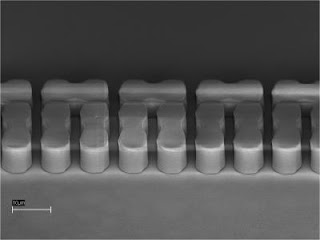The widely adopted technique of photolithography involves using a mix of light and chemicals to generate intricate micro- and nano-scale patterns on tiny areas of silicon. As part of the process, a thin polymer film – called a redistribution layer, and crucial to the effectiveness of device – is deposited onto the silicon wafer, in order to ease the signal propagation delay and to protect the chip from different environmental and mechanical factors.
PES cures, or dries and hardens, at 165 degrees Celsius, about 35 percent cooler than the other two materials. The need for less heat should translate directly into lower overhead costs for manufacturers, Lu said. Another advantage of PES is its low water uptake rate of less than 0.2 percent, less than the other materials. Additionally, PES adheres well to copper and can easily be made less brittle if needed. All of these attributes make PES a promising candidate for redistribution layer application and UV imprint lithography.
“The results demonstrate that PES is feasible to be used as UV-curable resist for both the redistribution application for electronic packaging and micro/nano imprint lithography,” said Rensselaer Research Associate Pei-I Wang, co-author of the paper.
Along with photolithography and on-chip nanoimprinting lithography, PES holds the potential for applications in other optical devices, flat-panel display, biotechnology devices, and microelectromechanical systems, Wang said. ###
In addition to Lu and Wang, co-authors on the paper include Rensselaer materials science and engineering professor Omkaram Nalamasu, who is also chief technical officer of Applied Materials Inc. in Santa Clara, Calif.; Rajat Ghoshal and Ram Ghoshal of Polyset Co. Inc. in Mechanicville, N.Y.; Charles Schaper of Transfer Devices Inc. in Santa Clara, Calif.; and Andrew Li of Applied Materials.
The project was funded through the New York State Foundation for Science, Technology and Innovation.
Lu’s research was conducted as part of Rensselaer’s Center for Integrated Electronics. The center’s multidisciplinary team of more than 50 faculty researchers and 100 graduate students aims to advance the role of electronic devices of our everyday lives by accelerating the production of the next generation of micro- and nanoelectronic devices and systems. The Center's mission is to build integrated top-down and bottom-up nanostructures, devices, and systems for information, biological, and broadband communication applications. Major activities include pioneering research into gigascale interconnects, 3-D interconnect structures, materials properties and process modeling, wideband gap semiconductors and devices, terahertz devices and imaging systems, power electronic devices and systems, and biochips.
For more information on Lu’s research and Rensselaer’s Center for Integrated Electronics, visit: www.rpi.edu/~lut/ and www.rpi.edu/dept/cie.
For more information on the new PES materials, visit: www.polyset.com.
About Rensselaer: Rensselaer Polytechnic Institute, founded in 1824, is the nation’s oldest technological university. The university offers bachelor’s, master’s, and doctoral degrees in engineering, the sciences, information technology, architecture, management, and the humanities and social sciences.
Institute programs serve undergraduates, graduate students, and working professionals around the world. Rensselaer faculty are known for pre-eminence in research conducted in a wide range of fields, with particular emphasis in biotechnology, nanotechnology, information technology, and the media arts and technology. The Institute is well known for its success in the transfer of technology from the laboratory to the marketplace so that new discoveries and inventions benefit human life, protect the environment, and strengthen economic development.
Contact: Michael Mullaney mullam@rpi.edu 518-276-6161 Rensselaer Polytechnic Institute
Technorati Tags: Nano or Nanotechnology and Nanotech or Rensselaer Polytechnic Institute and nanoimprinting lithography technology or John McCain Super Tuesday Speech VIDEO and W.E.B. (William Edward Burghardt) Du Bois and Berkeley Scientists Bring MRI/NMR to Microreactors or Matthew Alexander Henson

















No comments:
Post a Comment